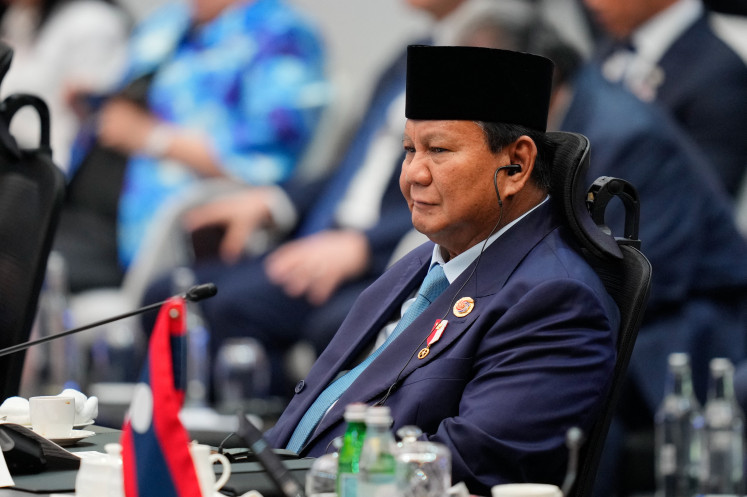Popular Reads
Top Results
Can't find what you're looking for?
View all search resultsPopular Reads
Top Results
Can't find what you're looking for?
View all search resultsI Wayan Mochoh: Promoting traditional Lampung music
(JP/Oyos Saroso HN)The communal conflict some time ago in South Lampung regency between Balinese and Lampung ethnic groups left most Balinese residents traumatized, including those living outside South Lampung
Change text size
Gift Premium Articles
to Anyone
(JP/Oyos Saroso HN)The communal conflict some time ago in South Lampung regency between Balinese and Lampung ethnic groups left most Balinese residents traumatized, including those living outside South Lampung. One of them was I Wayan Sumerta Dana Arta, alias Wayan Mochoh.
Wayan didn’t even dare to work in his office, which made him consider returning to Bali with his family for fear of being a target of mass rioting. However, he was prevented from leaving by his close friend and adopted sibling, one of Lampung’s leading artists.
“As Bang [brother] Syafril Yamin wouldn’t let me leave, I finally cancelled my return. He guaranteed our safety, asking me and my family to stay with him,” said Wayan.
Wayan is a Balinese artist who has developed and promoted the traditional arts of Lampung to other regions for over a decade. As a native of Bali, 41-year-old Wayan has since 1995 been a resident of Lampung.
In various national art events, he and his dance and music group have always represented Lampung, frequently winning national contests. In the latest national program in October 2012, the Traditional Arts Festival in Yogyakarta, the team under Wayan emerged as the winner.
He said he was planning to hold a thanksgiving in Balinuraga village to celebrate the victory of the traditional art troupe from this village at the arts festival in Yogyakarta.
Wayan has instructed Balinuraga youths for a long time. “They’re learning the traditional dance and music of Lampung instead of Bali. They also presented Lampung’s traditional performances at the festival in Yogyakarta,” said the graduate of the Indonesian Arts Institute (ISI), Denpasar, Bali.
He went to Lampung in 1995 at the request of then Lampung governor Poedjono Pranyoto to promote art among migrants from Bali in Lampung. After serving for a year, Wayan was appointed a civil servant by the Lampung Education and Culture Office. Later he married a Balinese girl and settled in Lampung.
Wayan said he had accepted Poedjono’s offer because he supported the governor’s idea to make Lampung a “mini Indonesia”, just in line with his aspirations to boost the nation’s cultural diversity.
“While studying at ISI, I also learned various Indonesian traditional arts like those of Java, Sunda and Padang,” he said.
In Lampung, his love of Lampung traditional art kept growing and he fervently delved into branches of local art such as dance, music and fine art. “In several aspects the traditional arts of Bali and Lampung have similarities. I’ve been teaching Lampung art to Balinese youths here because they’ve become Lampung residents,” he indicated.
“I’m also instructing woodcarving classes for indigenous Lampung people. We’ve been living peacefully with members of the local community. I’ve even been adopted as a younger brother of Lampung’s traditional musician, Syafril Yamin,” he said.
Wayan is known in Lampung to have identified the tones of cetik or gamolan pekhing, a traditional musical instrument of Lampung that is centuries old. Made from bamboo strips, according to Wayan the instrument was influenced by Chinese culture.
Along with Syafril Yamin, also a cetik craftsman, Wayan has introduced the traditional instrument to various schools in Lampung, besides holding workshops on cetik at art colleges in Indonesia, including ISI Denpasar and counterpart institutes in Bandung, Solo, Medan and Surabaya.
“ISI Denpasar plans to include cetik in the Indonesian music curriculum of the college. I’ll be striving to make Lampung’s traditional music a subject studied in all art colleges in Indonesia,” said Wayan, who holds a master’s degree in religion and culture from the Indonesian Hindu University, Denpasar.
Wayan has — again through working with Syafril Yamin — been teaching local students and teachers how to play cetik. Their hard work has made the traditional musical instrument popular in Lampung, its place of origin.
Wayan noted the resemblance of this instrument, also called gamolan pekhing, to those found in the likes of Bali, Java and Sulawesi. Nearly all regions have such bamboo musical instruments with different tones.
“Cetik is different from Sulawesi’s kulintang in its tone character. Cetik has six tones with a slight diatonic influence and Chinese touch, which I call the six-tone pelog key,” he said.
“The fourth tone, or fa, is missing. I think it’s due to the ethnic Chinese belief that number four connotes death, so that is omitted. That’s how Chinese culture affects this traditional instrument,” he said.
In February 2012, Wayan’s research on Lampung’s music was published in a book, Gamolan Pekhing (Bamboo musical instrument). “The book will be among the texts for extracurricular traditional music teaching in Lampung’s schools,” he added.
Wayan’s dedication to the traditional art of Lampung earned him a Cultural Masterpiece Award from the Indonesian Records Museum (MURI) in 2011. Wayan was described as having identified the six-tone pelog key of cetik and had popularized the traditional music among students.










